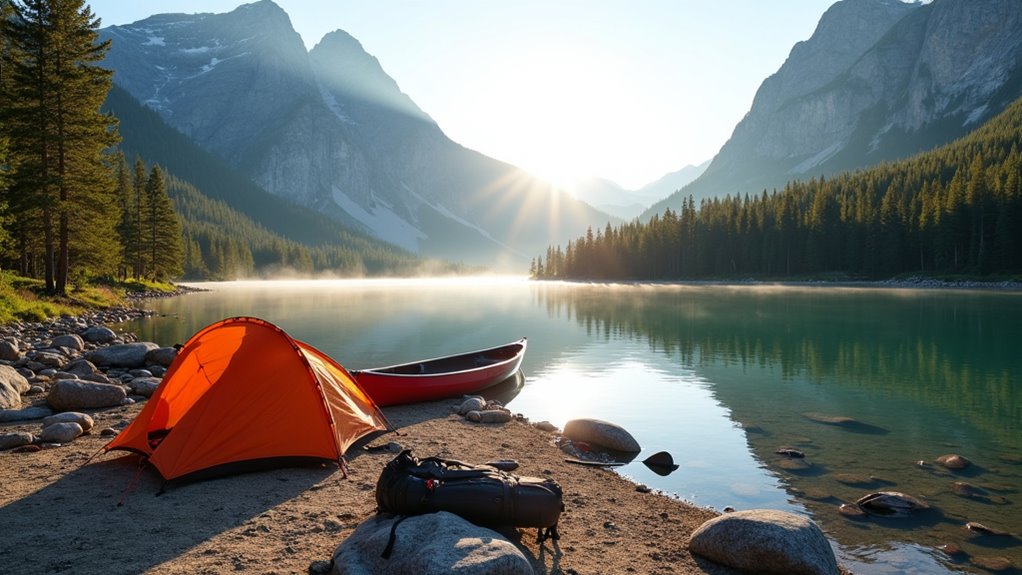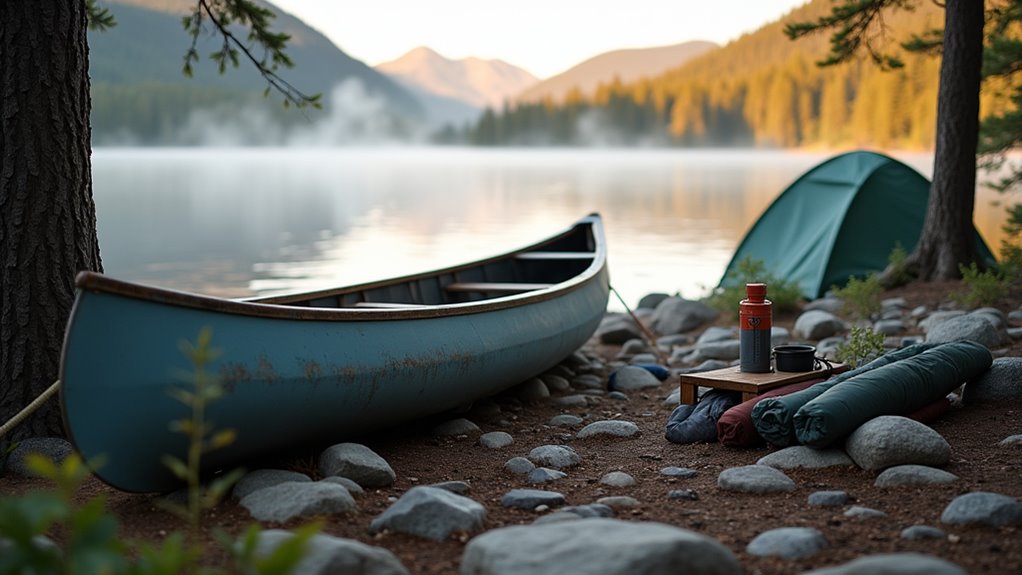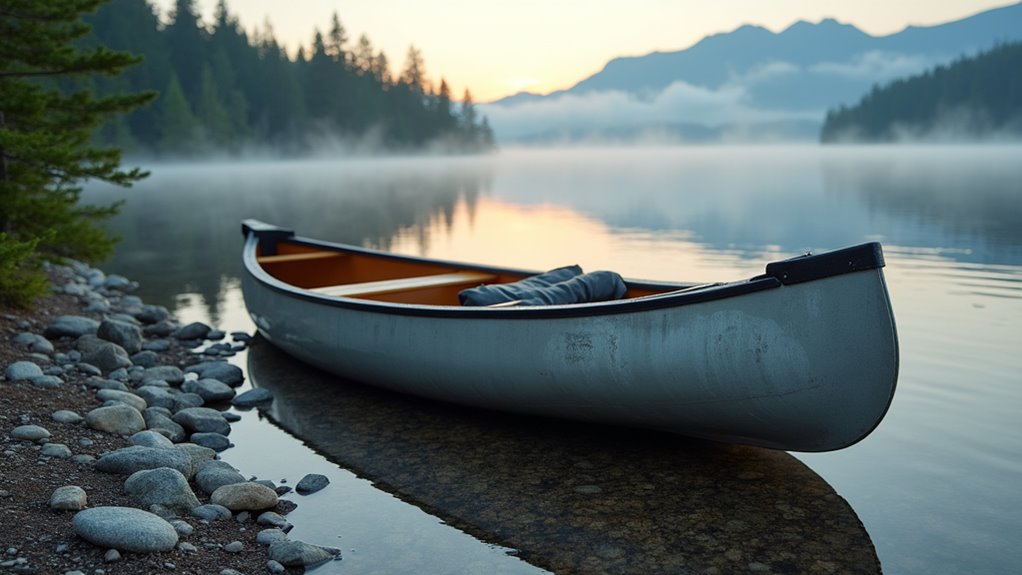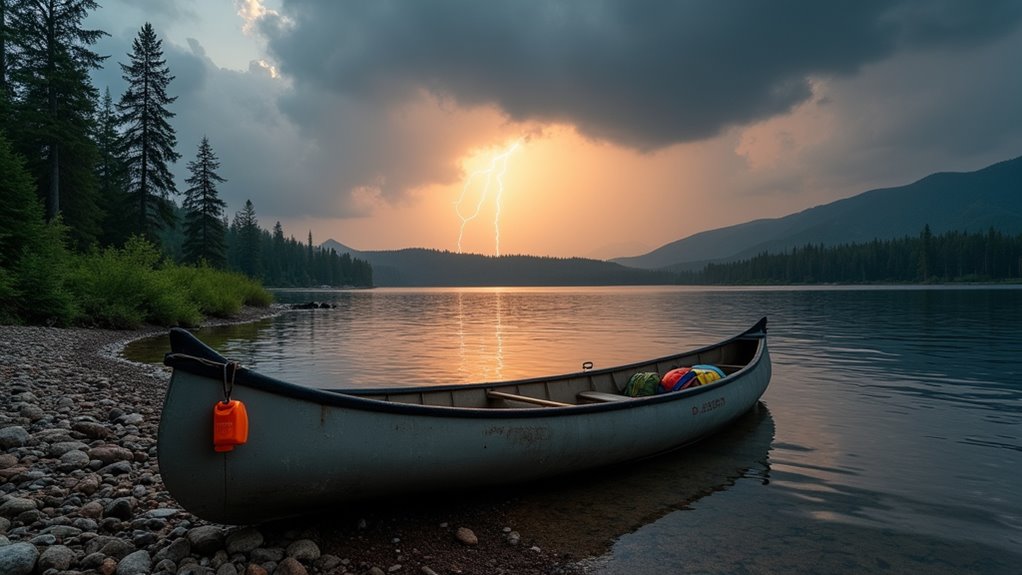Physical Address
304 North Cardinal St.
Dorchester Center, MA 02124
Physical Address
304 North Cardinal St.
Dorchester Center, MA 02124

Adventure awaits as canoe camping unveils hidden archaeological treasures and ancient portages that most wilderness explorers never discover.
You’ll discover that canoe camping routes often lead to hidden archaeological sites and ancient Native American portages that remain unmarked on modern maps. Unlike typical car camping, you’re carrying everything you need in a vessel that becomes both your transportation and cargo system across pristine waterways. The skills you’ll need go far beyond basic paddling—from reading water currents to weatherproofing your gear for multi-day expeditions. But here’s what most paddlers don’t realize before their first wilderness trip.

While you can get away with minimal gear on day trips, multi-day canoe camping demands careful planning and the right equipment to keep you safe, comfortable, and well-fed in the wilderness. You’ll need waterproof dry bags to protect your essentials from splashes and rain.
Multi-day canoe camping requires deliberate preparation and specialized waterproof gear to ensure wilderness safety and comfort.
Pack a lightweight tent designed for backpacking, a sleeping bag rated for expected temperatures, and an insulated sleeping pad for ground insulation.
Your cooking setup should include a portable camp stove, lightweight cookware, and non-perishable foods. Don’t forget water purification tablets or a portable filter since you can’t carry enough drinking water for multiple days.
Essential safety items include a first aid kit, headlamp with extra batteries, whistle, and weather radio. Pack everything in a systematic way to maintain your canoe’s balance.
For extended wilderness adventures, consider investing in a self-contained camping trailer that can be positioned at a base camp accessible by vehicle, allowing you to resupply between paddling segments.
Once you’ve assembled your gear, selecting the perfect waterway becomes your next critical decision. Consider your skill level first – beginners should choose calm lakes or slow-moving rivers with minimal rapids.
Research water levels, seasonal conditions, and weather patterns for your chosen dates. Check permit requirements and camping restrictions, as many waterways require advance reservations.
Study detailed maps to identify portages, campsites, and exit points. Plan realistic daily distances based on your group’s paddling experience and desired pace.
Factor in wind patterns, especially on large lakes where afternoon winds can create challenging conditions.
Popular beginner-friendly options include boundary waters, state park chains of lakes, and designated water trails.
Always have backup routes planned and inform someone of your intended itinerary before departing. Plus, research areas with dense vegetation or tall grass along shorelines where you might need to portage or set up camp, as these environments increase your risk of tick encounters during your canoe camping adventure.

After you’ve chosen your route, proper packing becomes the foundation of a successful canoe camping trip. You’ll want to distribute weight evenly between bow and stern, keeping heavier items low and centered. Pack the heaviest gear like food and water near the canoe’s center for ideal balance.
Waterproof storage isn’t optional—it’s essential. Use dry bags for clothing, sleeping gear, and electronics. Double-bag critical items like first aid supplies and fire-starting materials. Hard cases work well for fragile equipment.
Create an efficient loading system by packing items you’ll need during paddling in easily accessible spots. Keep your map, snacks, and rain gear within arm’s reach. Pack systematically, placing camp setup items together so you’re not searching through multiple bags when you reach your campsite.
When packing food for your canoe camping adventure, store all edible items in bear-proof containers or hang them properly to prevent unwanted wildlife encounters at your campsite.
Where should you set up camp when you’re miles from civilization with nothing but water and wilderness around you? Look for level ground at least 200 feet from the water’s edge to minimize environmental impact and avoid flooding.
Scout for natural windbreaks like rock formations or dense vegetation that’ll shield your tent from gusts off the water.
Check for overhead hazards—dead branches or unstable rocks that could fall during storms.
You’ll want good drainage, so avoid depressions where water collects. Rocky or sandy areas work better than soft soil that’ll turn muddy.
Establish your kitchen downwind from sleeping areas and store food properly to avoid attracting wildlife.
Always follow Leave No Trace principles by camping on durable surfaces and leaving your site cleaner than you found it.
Before heading out on remote canoe camping adventures, consider securing comprehensive travel insurance that covers outdoor activities and emergency evacuations from wilderness areas.

When you’re paddling across expansive lakes or steering winding river systems, solid navigation skills become your lifeline to safety and success. Always carry a waterproof map, compass, and GPS device as your primary navigation tools. Study your route beforehand, identifying landmarks, potential hazards, and bailout points.
Check weather conditions religiously – wind can transform calm water into dangerous whitecaps within minutes. Paddle close to shorelines when possible, and never venture onto open water during storms or high winds. Wear your life jacket constantly, not just when conditions look rough.
Tell someone your exact route and expected return time. If you’re crossing large bodies of water, travel with other canoeists whenever feasible. Trust your instincts – if conditions feel unsafe, they probably are.
After a long day of paddling, maintaining personal hygiene becomes challenging, so consider investing in camping showers to stay clean and comfortable during multi-day canoe trips.
Although your canoe gives you access to pristine wilderness areas, you’re entering spaces that wildlife calls home. Maintain respectful distances from all animals, especially during nesting seasons. Store food in bear canisters or hang it properly to prevent attracting wildlife to your campsite. Never feed animals, as this creates dangerous dependencies and aggressive behaviors.
Follow Leave No Trace principles religiously. Pack out everything you bring in, including food scraps and toilet paper. Use established campsites when available, and camp on durable surfaces like rock or gravel when dispersed camping. Keep fires small and use existing fire rings.
Wash dishes and yourself 200 feet from water sources using biodegradable soap. Dispose of human waste in catholes dug 6-8 inches deep, also 200 feet from water. When wildlife watching in forested areas along your route, move slowly and quietly to avoid startling animals and increase your chances of meaningful encounters.

Weather conditions can shift dramatically on waterways, transforming a peaceful paddle into a life-threatening situation within minutes. You’ll need to monitor forecasts constantly and recognize warning signs like sudden temperature drops, darkening clouds, or increasing wind speeds.
Pack essential emergency gear: waterproof first aid kit, emergency whistle, signaling mirror, and backup communication device. Always file a detailed float plan with someone reliable, including your route, timeline, and emergency contacts.
If storms threaten, immediately seek shelter on shore rather than riding it out on water. Lightning poses extreme danger to paddlers.
Know basic rescue techniques like self-rescue rolls and assisted recoveries.
Create redundant safety systems – multiple ways to start fires, purify water, and signal for help. Your preparation determines whether unexpected situations become minor inconveniences or major emergencies.
Consider investing in portable broadband solutions to maintain reliable internet connectivity for weather updates and emergency communications even in remote camping locations.
Before you venture into remote wilderness waterways, you’ll need solid paddling fundamentals that go far beyond basic strokes. Wilderness canoeing demands efficient technique, endurance, and the ability to handle challenging conditions when you’re miles from civilization.
Start by mastering J-strokes and draw strokes for precise control in tight channels. Practice paddling in wind and waves at your local lake before tackling exposed wilderness routes. Build your stamina gradually—wilderness trips often require 6-8 hours of daily paddling.
Wilderness canoeing demands more than basic paddling—master advanced strokes and build endurance before heading into remote waters.
Just as with recreational vehicles, taking time to research and avoid common buying mistakes ensures you select the right canoe and gear for your wilderness adventures.
You’ll discover that canoe camping isn’t just another outdoor adventure—it’s your passport to nature’s hidden theater. As you paddle into tomorrow’s sunrise, you’re painting memories that’ll last a lifetime. The wilderness whispers its secrets to those who listen, and you’ve earned your seat at nature’s table. So grab your paddle, trust your instincts, and let the waterways carry you toward experiences that’ll feed your soul long after you’ve returned home.